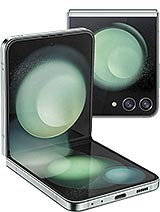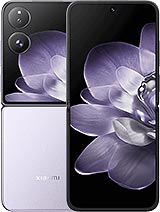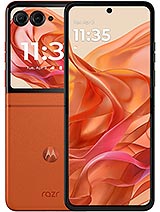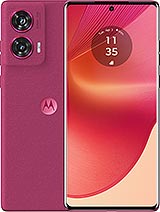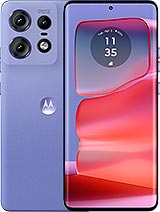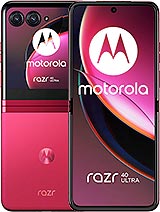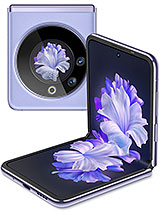Motorola Razr 50/razr (2024) review

A proper cover display, and a nice bendy one too
As befitting a Razr, the 50 has two displays - a foldable one on the inside, and a smaller additional one on the cover. The main panel is a 6.9-inch LTPO OLED with a 1,080x2,640px resolution in a tallish 22:9 aspect. It's sort of the same as on the 50 Ultra, but minus the Dolby Vision support (there's HDR10+) and with a maximum refresh rate of 'only' 120Hz (165Hz on the 50 Ultra).

The cover screen is one of the biggest upgrades for the vanilla Razr - in place of the tiny ticker-style unit of the 40, the 50 gets a real 3.6-inch display with a 1,056x1,066px resolution and a 90Hz maximum refresh rate. It's more or less the same one as on the 40 Ultra, with the 50 Ultra still maintaining superiority with its new 4-incher, and either new Razr looking cooler than competing Galaxies.

In our brightness testing, the internal display of the Razr 50 was good for just under 1,300nits - marginally better than the Razr 50 Ultra and higher than the Z Flip5, but not quite as bright as the Z Flip6. We also measured 1,323nits on the cover panel. The Razr 50 is in the upper echelon of clamshells in terms of brightness, that's for sure, even if Motorola isn't allowing more than mid-500s when adjusting the slider manually.
Refresh rate
Motorola has simplified the refresh rate handling for this generation - there are just two modes on the Razr 50, both of them adaptive, but with different ceilings. High is the one that will allow it to go up to 120Hz, while Standard limits things to 60Hz. In practice, as long as the screen is idle, the Razr 50 will dial down the refresh rate to 1Hz in either mode and then shoot up to the corresponding ceiling when you touch the display.

High frame rate gaming is also possible, though not all games that we know to support it actually triggered the high refresh rate mode. You can force the high refresh rate from the gaming utility, though it's not clear if that will actually allow the game to render at higher frame rates.
Streaming and HDR
Both displays support HDR10 and HDR10+, but Dolby Vision is missing here - the Ultra does have it. There's also Widevine L1 compliance, so you'll be getting DRM-protected content at up to FullHD - that's the case in Netflix.
We didn't get HDR in Netflix though, and in other cases the implementation is... unusual. For example, in YouTube we only got the phone to switch to HDR when displaying a video in full screen - not in any type of windowed playback. Semi-related, when an HDR YouTube video is switched to the PIP mode (the small window on top of whatever else you have on the screen), the window just goes black, with only sound coming out - that's not the case with non-HDR videos, which play back just fine.
Also not quite robust is the way the Razr 50 handles the Ultra HDR photo standard. It just doesn't work in Google Photos (which is the Razr's default gallery app), even though the phone does record the metadata - its photos do get the expected highlight brightness boost on other phones. The odd thing is that Ultra HDR does work in Chrome so the phone supports it.
Motorola Razr 50 battery life
The Motorola Razr 50 is powered by a 4,200mAh battery - the same capacity as last year's model, and still some more than the Razr 50 Ultra even though the Ultra model did get a modest increase this year (4,000mAh, up from 3,800mAh). The Galaxy Z Flips are packing smaller batteries too.
The Razr 50 aced two of the components of our Active Use test, posting class-leading results for video playback and web browsing. It was at the low end of the spectrum in gaming though, and about average in voice call longevity. So not the best foldable option for gaming (not that the chipset is great at it in the first place), but very good to great endurance otherwise.
Our new Active Use Score is an estimate of how long the battery will last if you use the device with a mix of all four test activities. You can adjust the calculation based on your usage pattern using the sliders below. You can read about our current battery life testing procedure here. For a comprehensive list of all tested devices so far, head this way.
Charging speed
The charging specs of the Razr 50 list the same 30W capability as the previous model; only the retail package has lost the 33W TurboPower adapter that came with the Razr 40. We used a Pixel 30W adapter for our testing, but any good Power Delivery unit rated for 30W or more should be able to max out the phone's rated input.

In our testing, the Razr 50 returned very similar numbers to the Razr 40's, reaching a full charge in just over an hour, with 59% showing in the battery indicator at the half-hour mark. That makes the vanilla Razr a little quicker than the Galaxy Z Flip5 and the Z Flip6, though not as quick as the Razr 50 Ultra.
The Razr 50 supports wireless charging up to 15W - an upgrade from the Razr 40's 5W capability and same as the Razr 50 Ultra and the competing Galaxy clamshells.
Speaker test
The Motorola Razr 50 has what's already shaping up as a conventional dual speaker setup - one front-facing unit sits above the display and also serves as an earpiece, and another one is placed next to the USB-C port at the bottom of the phone, for a stereo effect. Each speaker is only assigned the left or right stereo track and the phone will adjust which track goes where, based on the orientation.


Bottom speaker • Top speaker/earpiece
The Razr 50 earned an 'Very good' rating for loudness in our test, a notch below the 'Excellent' Ultra. The Ultra does sound bigger and boomier - the plain 50 is more mid-forward. We'd say the Moto is better than the Flips though, thanks to an overall louder and livelier output.
Use the Playback controls to listen to the phone sample recordings (best use headphones). We measure the average loudness of the speakers in LUFS. A lower absolute value means a louder sound. A look at the frequency response chart will tell you how far off the ideal "0db" flat line is the reproduction of the bass, treble, and mid frequencies. You can add more phones to compare how they differ. The scores and ratings are not comparable with our older loudspeaker test. Learn more about how we test here.
Reader comments
- jayde
- 23 Sep 2024
- 7MZ
My razr 40 lasted about 14 months and only developed problems because I kept using it on the beach and got sand in it. It then sounded a bit creaky when un/folding but worked fine. However, I later dropped it screen down on the floor in the house an...
- Luka3rd
- 23 Aug 2024
- JFk
My wife's Razr 40's screen cracked on the fold after 6 months... terrible quality.
- Droid Terminator
- 17 Aug 2024
- fu%
Oh this Samsung fans that are commenting on a Motorola Razr 50 must be call loser why because they come here to check how Moto manage to build a lower version of the premium Razr 50 Ultra but still have some better option than the Premium Flip 6 with...
